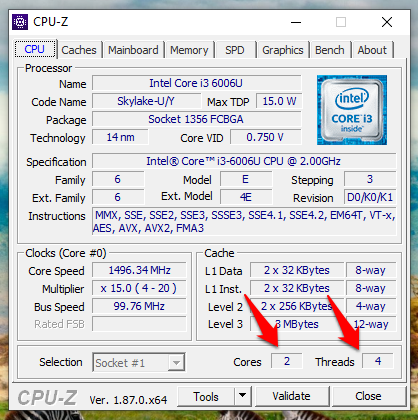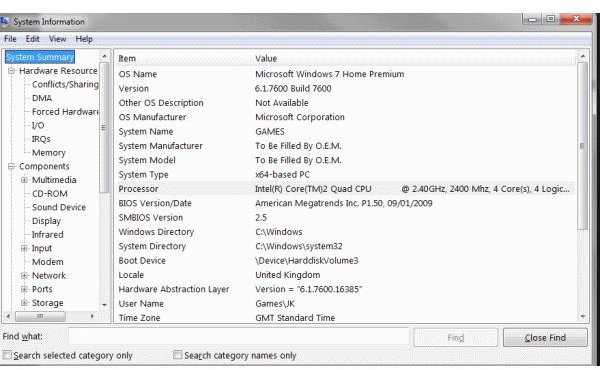How Do I Find Number Of Processors/cores Windows 2012r2 Server
- How To Find Number Of Cores In Windows Server 2003
- Cores Vs Logical Processors
- How To Find Number Of Cores In Windows Server 2008
Share this story.Windows Server 2016, not likely to arrive until the second half of next year, is going to shake up the way Microsoft licenses its server operating system, moving away from per socket licensing to per core. The change was first spotted by who is, for his sins, an expert on Microsoft licensing policies.Windows Server 2012 in the way Microsoft licensed its server operating system. The two main editions, Standard and Datacenter, had identical features, and differed only in terms of the number of virtual operating system instances they supported. Standard supported two VMs (in addition to the host OS); Datacenter was unlimited. Beyond that, they were identical.
This is the specification of my computer however i have problem finding out how many virtual cores are there in total. I would like to know if there is any command in windows 7 which would help me determine the number of virtual cores my CPU has. Mar 15, 2012 Windows Server and Processor Cores. If the processors also support Simultaneous Multithreading (SMT) (also known to some as Hyper Threading Technology (HTT) based on Intel's implementation) and the system has this option enabled, then the total logical processor count. Beginner Training Course; For Beginners; Report Designer Office Edition User Manual.NET Report Engine User Manual; Java Report Engine User Manual; Report Engine for RESTful User Manual.
The licenses for both editions were sold in two socket units; one license was needed for each pair of sockets a system contained.Windows Server 2016 makes that simple system less simple. First, it reinstates the functional differences between Standard and Datacenter editions. Datacenter will include additional storage replication capabilities, a new network stack with richer virtualization options, and shielded virtual machines that protect the content of a virtual machine from the administrator of the host operating system. These features won't be found in the Standard edition.Second, the licensing moves to a per core model.
How To Find Number Of Cores In Windows Server 2003

Instead of 2012's two socket license pack, 2016 will use a 2 core pack, with the license cost of each 2016 pack being 1/8th the price of the corresponding 2 socket pack for 2012. Each system running Windows Server 2016 must have a minimum of 8 cores (4 packs) per processor, and a minimum of 16 cores (8 packs) per system.For systems with up to 4 processors and up to 8 cores per processor, this won't change the overall licensing cost.

Above this, however, things get more expensive; although the price for a single processor 10 core system will remain the same, with two or or more sockets populated by 10 core processors, prices will go up; 2 or 4 processors with 10 cores per processor will cost 25 percent more to run Windows Server 2016 than they did 2012.This change brings Windows Server's licensing in line with SQL Server's; SQL Server 2014 switched to a per core model. So too did BizTalk 2013. Azure is also licensed on the basis of virtual machine cores, rather than sockets.
The switch is obviously a reaction to increasing processor core counts and, with it, reduced importance of high socket count systems.But this isn't a revenue neutral shift; it's going to end up costing some customers more money. This is a particular issue for those organizations that already have Software Assurance agreements that cover systems that were licensed using 2012's socket-based scheme.
Cores Vs Logical Processors
Microsoft's describes the way that licenses convert from 2012 to 2016; the number of new per core licenses received will depend on the result of an inventory of their current per socket licenses.
In the previous article in this series, we covered the differences between the various editions of Server 2012. In this article, we will take a look at what the minimum, recommended, and suggested requirements for installing and maintaining Windows Server2012.
How To Find Number Of Cores In Windows Server 2008
Like previous versions, Microsoft publishes the bare minimum to get the operating system installed. However, you need to take into account additional factors that will affect the hardware requirements. According to Microsoft, here are the basicminimum requirements for installing Server 2012.System RequirementsThe following sections cover the system requirements for the Windows Server 2012.
If your computer does not meet the minimum requirements, you will not be ableto install this product correctly. You should note that while the information below may list minimum or suggested requirements, the actual requirements will varybased on your system configuration, installed applications, roles, and features you install on the system.ProcessorThe number of processor cores, processor cache, and clock frequency of the CPU(s) will affect the actual requirements of the processor.
From a realistic implementation ofWindows Server 2012, it is not recommended to configure your server with the minimum requirements. You should start with the recommended requirement and takenote of the applications, roles, features and other services that will be running on the server. You may need to add multiple cores and/or increase the clock cycles.Microsoft recommends the following specifications for Server 2012. RequirementProcessorMinimum1.4 GHz 64-bit or faster single coreMinimum1.3 GHz 64-bit or faster multi coreRecommended3.1 GHz 64-bit or faster multi coreMemory (RAM)The server heavily depends on its RAM. RAM, or random access memory is very important for a server to process data.
The processors use memory to temporarily storeinformation while the processors are busy processing instructions. The server's RAM is also used to store data fetched from secondary storage (hard drives). While 32 bitsystems were limited on the amount of memory that can be accessed by the server, 64 bit systems can take advantage of much more memory space. However, this does not meanthat the more memory a server has, the better it will perform. How much memory your server requires depends on the applications, services, roles, and features that arerunning on the server. Here is a list of minimum and recommended memory requirements.
RequirementMemoryMinimum512 MB of RAM to boot for installationMinimum2 GB of RAM for installed systemRecommended8 GB of RAM or moreWhile Microsoft claims that 512 MB of RAM is the needed to start the installation process of Windows, it is highly recommended that you start with a few GB of RAM.StorageThe amount of storage your server will need will depend on the data that you plan on storing locally on the server. Microsoft has published that the installationof the server operating system will require a minimum of 32 GB of RAM. However, keep in mind that the amount of memory will increase the storage requirements becauseof the pagefile. Even the minimum requirement of 60 GB seems too little when considering that your server may have 16 GB of RAM. This will require approximately 24 GBof pagefile storage.

Realistically, you need over 100 GB for the system partition to have enough space to grow, especially when you start to apply updates andservice packs. Storage is relatively inexpensive so do not corner yourself by not configuring enough space on the system partition.